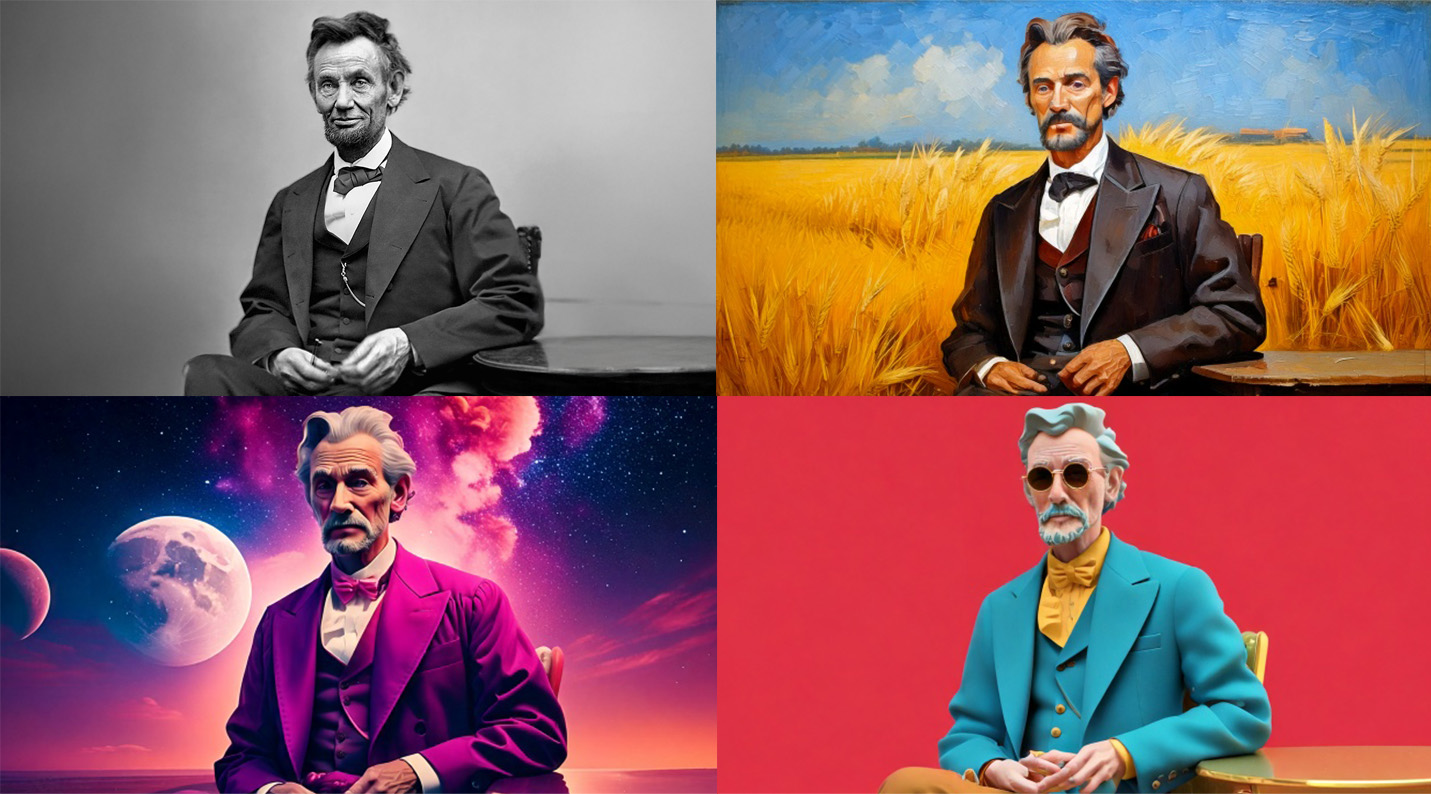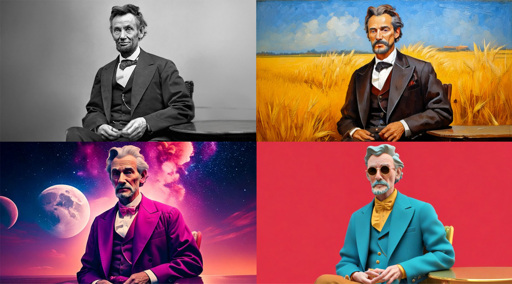What Happens When AI-Generated Lies Are More Compelling than the Truth?
-
Fake photographs have been around as long as photographs have been around. A widely circulated picture of Abraham Lincoln taken during the presidential campaign of 1860 was subtly altered by the photographer, Mathew Brady, to make the candidate appear more attractive. Brady enlarged Lincoln’s shirt collar, for instance, to hide his bony neck and bulging Adam’s apple.
In a photographic portrait made to memorialize the president after his assassination, the artist Thomas Hicks transposed Lincoln’s head onto a more muscular man’s body to make the fallen president look heroic. (The body Hicks chose, perversely enough, was that of the proslavery zealot John C. Calhoun.)
By the close of the nineteenth century, photographic negatives were routinely doctored in darkrooms, through such techniques as double exposure, splicing, and scraping and inking. Subtly altering a person’s features to obscure or exaggerate ethnic traits was particularly popular, for cosmetic and propagandistic purposes alike.
But the old fakes were time-consuming to create and required specialized expertise. The new AI-generated “deepfakes” are different. By automating their production, tools like Midjourney and OpenAI’s DALL-E make the images easy to generate—you need only enter a text prompt. They democratize counterfeiting. Even more worrisome than the efficiency of their production is the fact that the fakes conjured up by artificial intelligence lack any referents in the real world. There’s no trail behind them that leads back to a camera recording an image of something that actually exists. There’s no original that was doctored. The fakes come out of nowhere. They furnish no evidence.
Many fear that deepfakes, so convincing and so hard to trace, make it even more likely that people will be taken in by lies and propaganda on social media. A series of computer-generated videos featuring a strikingly realistic but entirely fabricated Tom Cruise fooled millions of unsuspecting viewers when it appeared on TikTok in 2021. The Cruise clips were funny. That wasn’t the case with the fake, sexually explicit images of celebrities that began flooding social media in 2024. In January, X was so overrun by pornographic, AI-generated pictures of Taylor Swift that it had to temporarily block users from searching the singer’s name.

What Happens When AI-Generated Lies Are More Compelling than the Truth? - by Nicholas Carr - Behavioral Scientist
What if the danger of AI-generated misinformation isn’t that we’ll believe it—it’s that we’ll eventually stop believing anything at all?

Behavioral Scientist (behavioralscientist.org)
-
Fake photographs have been around as long as photographs have been around. A widely circulated picture of Abraham Lincoln taken during the presidential campaign of 1860 was subtly altered by the photographer, Mathew Brady, to make the candidate appear more attractive. Brady enlarged Lincoln’s shirt collar, for instance, to hide his bony neck and bulging Adam’s apple.
In a photographic portrait made to memorialize the president after his assassination, the artist Thomas Hicks transposed Lincoln’s head onto a more muscular man’s body to make the fallen president look heroic. (The body Hicks chose, perversely enough, was that of the proslavery zealot John C. Calhoun.)
By the close of the nineteenth century, photographic negatives were routinely doctored in darkrooms, through such techniques as double exposure, splicing, and scraping and inking. Subtly altering a person’s features to obscure or exaggerate ethnic traits was particularly popular, for cosmetic and propagandistic purposes alike.
But the old fakes were time-consuming to create and required specialized expertise. The new AI-generated “deepfakes” are different. By automating their production, tools like Midjourney and OpenAI’s DALL-E make the images easy to generate—you need only enter a text prompt. They democratize counterfeiting. Even more worrisome than the efficiency of their production is the fact that the fakes conjured up by artificial intelligence lack any referents in the real world. There’s no trail behind them that leads back to a camera recording an image of something that actually exists. There’s no original that was doctored. The fakes come out of nowhere. They furnish no evidence.
Many fear that deepfakes, so convincing and so hard to trace, make it even more likely that people will be taken in by lies and propaganda on social media. A series of computer-generated videos featuring a strikingly realistic but entirely fabricated Tom Cruise fooled millions of unsuspecting viewers when it appeared on TikTok in 2021. The Cruise clips were funny. That wasn’t the case with the fake, sexually explicit images of celebrities that began flooding social media in 2024. In January, X was so overrun by pornographic, AI-generated pictures of Taylor Swift that it had to temporarily block users from searching the singer’s name.

What Happens When AI-Generated Lies Are More Compelling than the Truth? - by Nicholas Carr - Behavioral Scientist
What if the danger of AI-generated misinformation isn’t that we’ll believe it—it’s that we’ll eventually stop believing anything at all?

Behavioral Scientist (behavioralscientist.org)
This is 90% hyperbole. As always, believe none of what you hear and only half of what you see. We live most of our lives responding to shit we personally witnessed. Trust your senses. Of course the other part is a matter for concern, but not like the apocalyptic crowd would tell you.
It is always a safe bet that the snake oil salespeople are, once again, selling snake oil.
-
This is 90% hyperbole. As always, believe none of what you hear and only half of what you see. We live most of our lives responding to shit we personally witnessed. Trust your senses. Of course the other part is a matter for concern, but not like the apocalyptic crowd would tell you.
It is always a safe bet that the snake oil salespeople are, once again, selling snake oil.
believe none of what you hear and only half of what you see.
This has caused a huge amount of problems in the last decade or so, and isn't necessarily something to celebrate.
-
believe none of what you hear and only half of what you see.
This has caused a huge amount of problems in the last decade or so, and isn't necessarily something to celebrate.
Yep because in the end you‘ll believe in something regardless and that something is whatever sits right with you more often than not.
-
This is 90% hyperbole. As always, believe none of what you hear and only half of what you see. We live most of our lives responding to shit we personally witnessed. Trust your senses. Of course the other part is a matter for concern, but not like the apocalyptic crowd would tell you.
It is always a safe bet that the snake oil salespeople are, once again, selling snake oil.
The trick is, snake oil salesmen exist because there are customers. You might be smart enough to spot them coming, but many, many, many people are not. Being dismissive of scamming as an issue because you can spot them is like being dismissive of drownings because you know how to swim. It ignores the harm to your world done by having others around you destroyed, sometimes because they are cocky and hubristic, sometimes just because they were caught in a weak moment, just a bit too tired to notice the difference between rn and m in an email address.
-
Fake photographs have been around as long as photographs have been around. A widely circulated picture of Abraham Lincoln taken during the presidential campaign of 1860 was subtly altered by the photographer, Mathew Brady, to make the candidate appear more attractive. Brady enlarged Lincoln’s shirt collar, for instance, to hide his bony neck and bulging Adam’s apple.
In a photographic portrait made to memorialize the president after his assassination, the artist Thomas Hicks transposed Lincoln’s head onto a more muscular man’s body to make the fallen president look heroic. (The body Hicks chose, perversely enough, was that of the proslavery zealot John C. Calhoun.)
By the close of the nineteenth century, photographic negatives were routinely doctored in darkrooms, through such techniques as double exposure, splicing, and scraping and inking. Subtly altering a person’s features to obscure or exaggerate ethnic traits was particularly popular, for cosmetic and propagandistic purposes alike.
But the old fakes were time-consuming to create and required specialized expertise. The new AI-generated “deepfakes” are different. By automating their production, tools like Midjourney and OpenAI’s DALL-E make the images easy to generate—you need only enter a text prompt. They democratize counterfeiting. Even more worrisome than the efficiency of their production is the fact that the fakes conjured up by artificial intelligence lack any referents in the real world. There’s no trail behind them that leads back to a camera recording an image of something that actually exists. There’s no original that was doctored. The fakes come out of nowhere. They furnish no evidence.
Many fear that deepfakes, so convincing and so hard to trace, make it even more likely that people will be taken in by lies and propaganda on social media. A series of computer-generated videos featuring a strikingly realistic but entirely fabricated Tom Cruise fooled millions of unsuspecting viewers when it appeared on TikTok in 2021. The Cruise clips were funny. That wasn’t the case with the fake, sexually explicit images of celebrities that began flooding social media in 2024. In January, X was so overrun by pornographic, AI-generated pictures of Taylor Swift that it had to temporarily block users from searching the singer’s name.

What Happens When AI-Generated Lies Are More Compelling than the Truth? - by Nicholas Carr - Behavioral Scientist
What if the danger of AI-generated misinformation isn’t that we’ll believe it—it’s that we’ll eventually stop believing anything at all?

Behavioral Scientist (behavioralscientist.org)
The thing about compelling lies is not that they are new, just that they are easier to expand. The most common effect of compelling lies is their ability to get well-intentioned people to support malign causes and give their money to fraudsters. So, expect that to expand, kind of like it already has been.
The big question for me is what the response will be. Will we make lying illegal? Will we become a world of ever more paranoid isolationists, returning to clans, families, households, as the largest social group you can trust? Will most people even have the intelligence to see what is happenning and respond? Or will most people be turned into info-puppets, controlled into behaviours by manipulation of their information diet to an unprecedented degree? I don't know.






